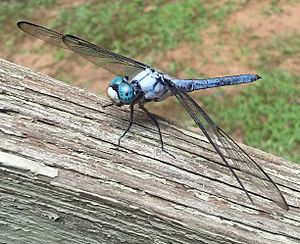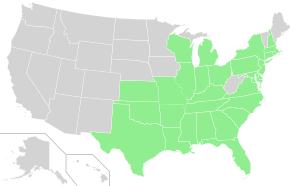Great blue skimmer facts for kids
Quick facts for kids Great blue skimmer |
|
|---|---|
 |
|
| Scientific classification | |
| Kingdom: | |
| Phylum: | |
| Class: | |
| Order: | |
| Suborder: | |
| Family: |
Libellulidae
|
| Genus: |
Libellula
|
| Species: |
L. vibrans
|
| Binomial name | |
| Libellula vibrans (Fabricius, 1793)
|
|
 |
|
| Range of L. vibrans | |
The great blue skimmer (Libellula vibrans) is a type of dragonfly that belongs to the skimmer family. It's one of the biggest skimmer dragonflies you can find!
With a total length of 50 to 63 mm, it is quite a large insect. Young great blue skimmers are brown in color. But as they get older, they change to a beautiful blue. This species is found near lakes, ponds, and slow streams. You can spot them in the eastern United States and sometimes in southern Ontario, Canada.
Contents
Meet the Great Blue Skimmer
The great blue skimmer is a fascinating insect. It is known for its impressive size and striking color change. These dragonflies are important parts of their ecosystems. They help control populations of smaller insects. They are also a sign of healthy water environments.
What Does It Look Like?
The great blue skimmer is one of the largest skimmer dragonflies. It can grow to be about 5 to 6.3 centimeters long. That's roughly the length of your thumb! When these dragonflies are young, they have a brown body. This helps them blend in with their surroundings.
As they mature, their bodies turn a bright, powdery blue. This blue color is what gives them their name. Both males and females show this color change. However, the blue is often more vibrant in the males. Their wings are clear, but they might have small dark spots near the tips.
Where Does It Live?
Great blue skimmers love to live near water. You can often find them flying around lakes, ponds, and slow-moving streams. They prefer areas with lots of plants growing in and around the water. These plants provide places for them to hunt and rest.
Their main home is in the eastern parts of the United States. They are common in states like North Carolina and Florida. Sometimes, they can also be seen in the very southern parts of Ontario, Canada. They need clean water to thrive. So, seeing them is a good sign that the water is healthy.
What Do They Eat?
Like all dragonflies, the great blue skimmer is a skilled hunter. They are carnivores, meaning they eat other animals. Their diet mainly consists of smaller flying insects. They catch their prey right out of the air.
They are very fast and agile flyers. This helps them snatch mosquitoes, flies, and gnats. They use their strong legs to grab their prey. Then they eat it while still flying. This helps keep insect populations balanced.
Life Cycle of a Dragonfly
The life cycle of the great blue skimmer, like other dragonflies, has three main stages. It starts as an egg. The female dragonfly lays her eggs in or near the water. These eggs hatch into tiny nymphs.
The nymph stage is spent entirely underwater. Nymphs are also predators. They hunt small aquatic creatures. They grow by shedding their skin many times. This stage can last for months or even years. When a nymph is ready, it crawls out of the water. It then sheds its skin one last time. This is when it transforms into an adult dragonfly. The adult dragonfly then flies, mates, and lays eggs. This completes the life cycle.

